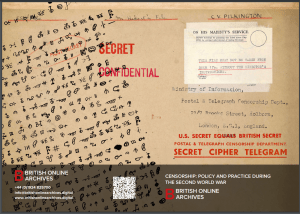British Online Archives – Censorship: Policy and Practice During the Second World War
 Access via Library Catalogue.
Access via Library Catalogue.
Censorship: Practice and Policy during the Second World War explores British postal and telegraph censorship throughout a pivotal era of modern history. The collection contains images drawn from Ministry of Defence files at The National Archives. It begins by surveying the first tentative steps that were taken, following the outbreak of conflict in 1939, to implement and to co-ordinate censorship. Documents reveal how hastily-assembled censorship teams looked back to the First World War for lessons and instructional precedents whilst adapting to the major technological developments that had occurred since. The work undertaken by censorship units — which necessitated keeping a close eye on all communications that could reveal sensitive or dangerous information to the enemy — soon became one of the most important, if somewhat underappreciated, fronts in the so-called “secret war”. Censorship became a wide-ranging, international endeavour. It involved not just Britain, but also the Dominions, colonies, allies (including the USA), and neutral states such as Ireland. Censorship teams sprung-up across the globe, typically employing local people, especially women. Censors from a wide variety of backgrounds became adept at breaking codes and recognising suspect material, even if it was cleverly concealed.
Like this database? Please leave a comment.
Categories
Leave a Reply